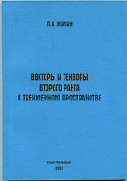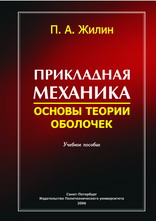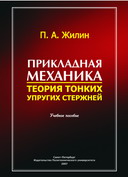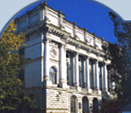|
“There is no action
without reason in nature; comprehend the reason and you won't
need the experience.”
Leonardo da Vinci
The most significant features of scientific society in the end of
XX — beginning of XXI century are pragmatism and particular
specialization. To the least degree this can be applied to Pavel
Andreevich Zhilin. Sincere interest, willing to perceive the Truth
and to bring his knowledge to people were the solely motives for
his work. Breadth of scientific interests of P.A. Zhilin is
impressing — having fundamental character, his works cover
practically all areas of mechanics and are extended to
electrodynamics and quantum physics. Hardly anyone can express the
views of P.A. Zhilin on science better than himself:
 “Aim of each science is in perception of the Reality. At the
same time the science investigates not the Reality itself, but the
simplified models of the Reality. Approaching to the true Reality
can be achieved by broadening the model. But to construct a model
we need to know at least, what exactly we are going to model. In
other words we have to have an a priori idea of the Reality. So we
have a vicious circle — to perceive the Reality we need a
science, and to construct a science we need to know the Reality.
Fortunately the solution of this one would think unsolvable
problem is integrated in the human mind, which has two
qualitatively different categories: a) intuition and b) intellect.
Intuition is the ability of a human being to sense the world
around us directly, which can not be reduced to the five basic
senses. This is what poets, musicians, painters and other artists
are conscious of. Intuition may be trained as well as every other
ability of human being, but it requires permanent and purposeful
efforts.
Intellect is an ability of human being to think logically, basing
on an a priori knowledge, “built in” the intellect “memory”.
A powerful modern computer is a practically perfect analogue of
intellect.”
“Aim of each science is in perception of the Reality. At the
same time the science investigates not the Reality itself, but the
simplified models of the Reality. Approaching to the true Reality
can be achieved by broadening the model. But to construct a model
we need to know at least, what exactly we are going to model. In
other words we have to have an a priori idea of the Reality. So we
have a vicious circle — to perceive the Reality we need a
science, and to construct a science we need to know the Reality.
Fortunately the solution of this one would think unsolvable
problem is integrated in the human mind, which has two
qualitatively different categories: a) intuition and b) intellect.
Intuition is the ability of a human being to sense the world
around us directly, which can not be reduced to the five basic
senses. This is what poets, musicians, painters and other artists
are conscious of. Intuition may be trained as well as every other
ability of human being, but it requires permanent and purposeful
efforts.
Intellect is an ability of human being to think logically, basing
on an a priori knowledge, “built in” the intellect “memory”.
A powerful modern computer is a practically perfect analogue of
intellect.”
From the paper “Reality and Mechanics”
 Doctor of Science, professor, author of more than 200 scientific
papers, many of which were published
in the key scientific journals, a Teacher who educated more than
one generation of disciples — both PhD and Dr. Sci, P.A. Zhilin
was a mind of a wide scope and of great erudition.
Being by his position an adherent of the rigorous Science, he was also deeply
interested in Eastern philosophies. Fundamental scientific ideas of Pavel
Andreevich, concerning the importance of spinor motions when describing
events at the micro-level and modelling the electromagnetic field,
are in correspondence with different metaphysical concepts of the
origin of the World. These ideas in various forms were proposed by
the great classics of science, whose works Pavel Andreevich
studied in a deep and detailed way. The achievement of Pavel
Andreevich is the translation of these ideas from a vague general
form of words and intuitive assumptions into a rigourous form of
mathematical models. The things he writes on intuitive perception
of the world around us is based not only on books, but on his own
experience of direct perception of scientific knowledge:
Doctor of Science, professor, author of more than 200 scientific
papers, many of which were published
in the key scientific journals, a Teacher who educated more than
one generation of disciples — both PhD and Dr. Sci, P.A. Zhilin
was a mind of a wide scope and of great erudition.
Being by his position an adherent of the rigorous Science, he was also deeply
interested in Eastern philosophies. Fundamental scientific ideas of Pavel
Andreevich, concerning the importance of spinor motions when describing
events at the micro-level and modelling the electromagnetic field,
are in correspondence with different metaphysical concepts of the
origin of the World. These ideas in various forms were proposed by
the great classics of science, whose works Pavel Andreevich
studied in a deep and detailed way. The achievement of Pavel
Andreevich is the translation of these ideas from a vague general
form of words and intuitive assumptions into a rigourous form of
mathematical models. The things he writes on intuitive perception
of the world around us is based not only on books, but on his own
experience of direct perception of scientific knowledge:
 “It is principally possible to use intuitive and
intellectual methods of perception independently one of another.
Intuitive perception has an imperfection of being impossible to
teach it. However namely the intuitive method underlies the
creation of scientific models. Pure intellectual approach can make
semblance of scientific discoveries, but in fact it's fruitless.
In the last decades special popularity was gained by the so
called “black box” philosophy, which refers to the intellectual
method achievement. It seemed that this way could bring us to
success. But in actual fact it turned out that the black box is
worth only when it is transparent, that is when we know its inside
beforehand. The merit of the intellectual method is that it can be
taught easily. Let us characterize the intellectual method with the words of
Einstein: “Science is a creation of human mind with its freely
invented ideas and notions”.
Intuitive method of cognition is best defined by the words of
Socratus: By intuitive perception “soul is climbing up the
highest observation tower of Being”. The main thesis of this work is that
no real development of
science is possible without immediate participation of intuition
and there are neither freely invented ideas nor notions existing
in nature.”
“It is principally possible to use intuitive and
intellectual methods of perception independently one of another.
Intuitive perception has an imperfection of being impossible to
teach it. However namely the intuitive method underlies the
creation of scientific models. Pure intellectual approach can make
semblance of scientific discoveries, but in fact it's fruitless.
In the last decades special popularity was gained by the so
called “black box” philosophy, which refers to the intellectual
method achievement. It seemed that this way could bring us to
success. But in actual fact it turned out that the black box is
worth only when it is transparent, that is when we know its inside
beforehand. The merit of the intellectual method is that it can be
taught easily. Let us characterize the intellectual method with the words of
Einstein: “Science is a creation of human mind with its freely
invented ideas and notions”.
Intuitive method of cognition is best defined by the words of
Socratus: By intuitive perception “soul is climbing up the
highest observation tower of Being”. The main thesis of this work is that
no real development of
science is possible without immediate participation of intuition
and there are neither freely invented ideas nor notions existing
in nature.”
From the paper “Reality and Mechanics”
Having administrative positions of the head of the Chair of
Theoretical Mechanics at the Saint Petersburg Polytechnical
University, head of laboratory “Mechanical systems dynamics” at
the Institute for Problems in Mechanical Engineering Russian
Academy of Sciences, taking active part in the life of society —
being member of the Russian National Committee for Theoretical and
Applied Mechanics, member of International Society of Applied
Mathematics and Mechanics (GAMM), member of Guidance Board
Presidium for Applied Mechanics Ministry of Higher Education RF,
full member of Russian Academy of Sciences for durability
problems, member of three Dissertation Councils, first of all
P.A. Zhilin was a Scientist, for whom the science has become the
sense of life and the cause of life. He was a Teacher who
influenced not only his immediate disciples — PhD students and
persons working for doctor's degree, but also many people
considering themselves his disciples to a greater or lesser
extent.

 P.A. Zhilin considered one of his main tasks broadening the range
of application for mechanics and describing phenomena, being
studied in the different fields of natural science from common
rational positions, peculiar to mechanics. The following quotation
expresses the views of P.A. Zhilin on mechanics as a method of
studying nature and on the role mechanics should play in the
science of XXI century:
P.A. Zhilin considered one of his main tasks broadening the range
of application for mechanics and describing phenomena, being
studied in the different fields of natural science from common
rational positions, peculiar to mechanics. The following quotation
expresses the views of P.A. Zhilin on mechanics as a method of
studying nature and on the role mechanics should play in the
science of XXI century:
“Mechanics is not a theory of whatever Phenomenon, but a
method of investigation of nature. There is no law in the foundations of
mechanics, which could be disproved experimentally, not even in
principle. In the foundation of mechanics there are logical statements
which express balance conditions for certain quantities, and per se
they are insufficient for the construction of any closed theory. One
has to attract supplementary laws, like the law of gravity, regarded
as facts experimentally determined. These supplementary laws may come
out to be insufficient or even erroneous, but rejecting them does
not influence methods of mechanics. The mentioned nonclosure of
mechanics may be considered as its loss by people who think that
the humanity is close to the final understanding of the universe. But
those who are able to see the Reality, understand how
infinitely far people are from ability to describe even
relatively simple phenomena of the Reality. That is why the correct
method of studying nature is to include a priori indefinite
elements, manipulating by which one could improve these or those
theories of phenomena of various nature and in that way broaden
our idea of Reality. Mechanics sets certain limits for the
acceptable structure of these indefinite elements, but preserves a
wide enough freedom for them.”
From the paper “Reality and Mechanics”

 One of the most important results of the scientific and
educational work of P.A. Zhilin is his book of about 1000 pages,
which was published only partly during his life. The book
represents a course of the Eulerian mechanics, which takes into account
on equal terms both translational and rotational degrees of freedom.
In this book P.A. Zhilin shares with the reader his ideas related to the
taking into consideration spinor motions on the micro-level, application of
open bodies models, and introduction of the characteristics of physical state
(temperature, entropy, chemical potential) by methods of rational mechanics.
One of the most important results of the scientific and
educational work of P.A. Zhilin is his book of about 1000 pages,
which was published only partly during his life. The book
represents a course of the Eulerian mechanics, which takes into account
on equal terms both translational and rotational degrees of freedom.
In this book P.A. Zhilin shares with the reader his ideas related to the
taking into consideration spinor motions on the micro-level, application of
open bodies models, and introduction of the characteristics of physical state
(temperature, entropy, chemical potential) by methods of rational mechanics.
P.A. Zhilin dreamed to open a way to the microworld for the
rational mechanics, and to include there the electrodynamics. Many
people dream and many people issue big challenges for themselves,
but only few of them succeed.
P.A. Zhilin knew to make his dreams a reality.
Within the limits of classical mechanics he offered continuum
models, whose mathematical description is coming to
electrodynamics and quantum mechanics equations. Views of
P.A. Zhilin often disagree with the common point of view, his
ideas are raising debates, but
“Who argues, appealing to an authority, uses not his brain, but
rather his memory.”
Leonardo da Vinci
|


